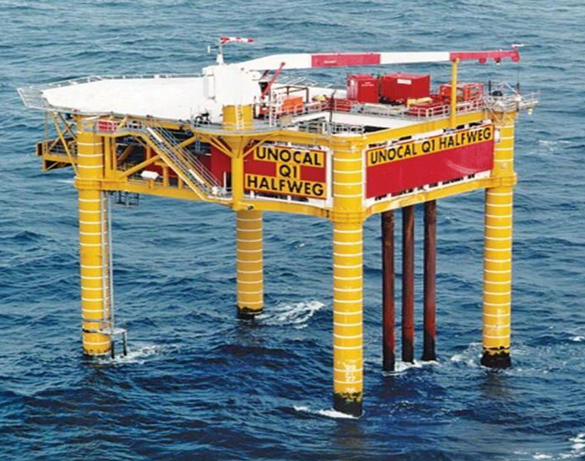Business Overview
The Q/1 Gas Field was discovered in 1968 in the Dutch sector of the North Sea. Two appraisal wells drilled in 1974 and 1980 failed to make this reservoir economically productive.
Challenges
The reservoir in the Rotliegendes Sandstone had very low permeability (0.1-0.5 mD). It contained clay particles which migrated with gas and fluid flows, plugging up the near-wellbore pore spaces. This could only be overcome by minimising near-wellbore flow rates, and ensuring that once productive, no liquids were reintroduced to the reservoir.
Traditional North Sea platforms were too expensive to meet the economic threshold. Hence, lighter weight alternatives were researched, including the innovative self-installing gravity-based jack-up solution. However, such platforms would not support traditional production processes and measurement systems such as a test separator. Data gathering would have to be sacrificed to allow development to proceed.
Solution
The development of horizontal drilling by Unocal Netherlands in the late 1980’s prompted exploitation of the Q/1 Gas Field to be reconsidered.
- Horizontal well performance was simulated to research possible productivity gains.
- A minimal facilities development philosophy was adopted, which allowed a new light weight class of platform to be considered.
- This was the first self-installing gravity-based jack-up structure to be used in the North Sea.
The modelled productivity gains and the lower cost estimates for the novel structure indicated the project could be very attractive economically, if de-risked by first drilling a horizontal well to test that the technology would yield sufficient productivity.
- Drilling and completion methods were designed to exclude all wellbore fluids.
- To minimise clay migration, constraints were imposed on the rate at which wells were brought into production – based on core tests in the laboratory.
- The self-installed platform was chosen as the lowest cost, safe alternative to support the gas wellheads. No accommodation was installed. The platform was one of the earliest Normally Unmanned Installations.
- No process systems were installed. All untreated fluids were piped to a nearby oil platform for treating to sales quality.
The first horizontal well was drilled and tested in 1991. A threshold test rate of 10 mmscfd was required by the economics. The actual test flowed at 17 mmscfd.
This result spurred project development. Two other horizontal wells were drilled draining the axial crest of the tight reservoir. The unmanned platform was installed, the first of its kind.
Results & Benefits
Once drilled and carefully tested the A1 horizontal well proved full field development was economically viable. Initial production showed that the innovations overcame the challenges and resulted in a very profitable asset, developed 25 years after discovery.
- Profitable project with a productive life of over ten years.
- Careful and novel approaches in well design, drilling, facilities design, reservoir management and development planning were all successful.
Considering the trade-off between progressing with an innovative untraditional development, but with substandard data gathering, or no project at all, a pragmatic final investment decision was taken with exceptional results. This was noted by the industry as a new trajectory.

